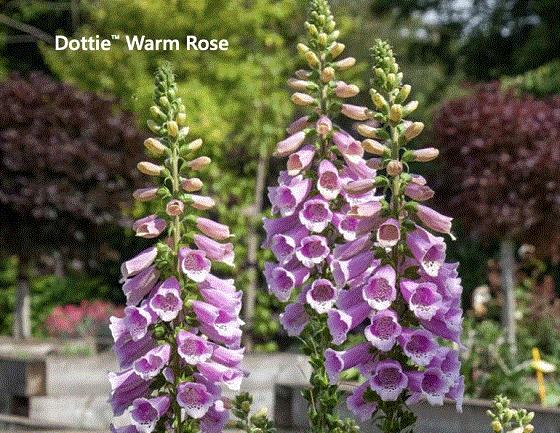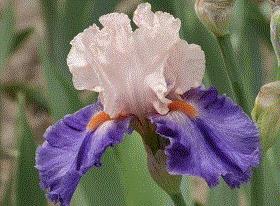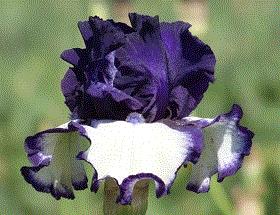What’s Happening Here?
A few weeks ago, I came across a peculiar looking batch of Physostegia Crystal Peak White. The primary symptoms were upward cupped leaves and unusual yellow/white patterns on many of the new and recently matured leaves.
Some plants exhibited only one of these symptoms, while others had both. Is this some type of mutation or reversion, chemical injury, a virus or are these symptoms caused by somthing else?
With that, the time has come for me to ask, “What’s happening here?” Stay tuned and I’ll reveal the answer in a little while.
Digitalis Dottie Series

ThinkPlants is offering a new digitalis series from Syngenta flowers. There are four individual colors in the series (Cream, Peach, Purple and Warm Rose), as well as a mix of them. The Dottie series is first-year flowering and will bloom reliably without vernalization. They're about 1/3 shorter than most of the varieties on the market and each cultivar is well branched, producing multiple flower spikes per plant. The series is early to flower, blooms uniformly and produces large flowers on strong stems. Hardy to Zone 4.
Schreiner's Gardens Celebrates Its 100th
Americas largest iris farm is celebrating their Centennial Anniversary May 2 to June 1, 2025 at its a annual Bloom Season Event.
Before I get to the celebratory details, here’s a brief recap of Schreiner’s Gardens:
Since 1925, the Schreiner family has dedicated themselves to cultivating and hybridizing the finest quality iris. Today, Schreiner’s Gardens boasts 140 acres of iris production, along with its breathtaking 10-acre display garden. For a century, this family owned-and-operated farm has inspired generations with its unparalleled iris varieties, pioneering hybridization techniques and deep commitment to excellence. Highlighted over the years by Martha Stewart, Better Homes & Gardens, and Sunset magazine, Schreiner's is known for their meticulous growing standards and quality of iris rhizomes.
Schreiner’s Gardens opens their 10-acre display gardens and expansive iris fields in Salem, Oregon, during bloom season for about three weeks in early May. Visitors can stroll through the gardens and fields and take in the vibrant tapestry of over 500 iris cultivars. Attendees will see limited-edition iris varieties, historical displays and attend several special events, such as an artist fair over the course of the three-week event. Now into its fourth-generation of family operations, Schreiner’s Gardens’ legacy is their dedication to sharing and growing beauty.
2025 Bloom Season Event
Where: Schreiner’s Gardens – Salem, Oregon
When: May 2 to June 1, 2025
Hours: 9:00 a.m. to 6:00 p.m.

Irises: Past, Present & Future
With Schreiner’s Gardens hosting their centenary celebration, I reached out to Ben Schreiner, fourth-generation owner of Schreiner's Gardens, to ask him a few questions about the iris industry today and where he sees it going. (Before you look twice and think I misphrased that last sentence, I wanted to confirm that "centenary" is a real word; a centenary is the 100th anniversary of an event.)
Paul: How has iris growing and hybridizing changed over the past 100 years?
Ben: The biggest change in growing over the last 100 years is probably the use of herbicides. Prior to using them, the fields would have to be hand hoed at least twice a year. That entailed a crew of 100 people to keep up with the weeds. Herbicides have eliminated that work. There has also been more mechanization in the digging and planting processes. But it's still difficult to fully mechanize the entire production process, given that irises are rhizomes with roots and foliage, so there is still a need for that human touch.
|

Party Hat
|

Stepping In
|
Schreiner’s Gardens has 25 new iris introductions for 2025. Party Hat (left) has seashell pink standards set upon violet purple falls accented by flaming orange beards. Stepping In (right) is modern plicata (the edges of the petals are banded with a darker color against a lighter ground color) that produces an impressive 13 flowers per stalk.
Paul: How has has hybridizing changed?
Ben: In terms of hybridizing, new color patterns, fuller and wider petals, and increased remontancy (reblooming) are the biggest advancements seen.
Paul: Where is the iris industry today?
Ben: I think the industry is in a good place right now. The COVID pandemic increased interest in gardening and that has been seen with irises. Irises also offer appeal to the novice and expert gardener alike. Being a very low-maintenance perennial, they are great for the beginner gardener. But because of the sheer number of varieties, it's easy for a more experienced gardener to become captivated with them as well.
Paul: Where is it likely to go in the future?
Ben: I imagine we'll continue to see advancements in hybridizing, such as more buds per stalk and new color patterns. I hope that dwarf bearded irises can become more popular. Given their size, they are ideal for pots and allow those living in apartments and people without a huge amount of outdoor space to still enjoy irises.
I’d like to thank Ben for taking time out of his busy schedule to answer these questions. I’d also like to take a quick moment to congratulate the Schreiner family for reaching this historic milestone.

The Answer is ...
At the top of the newsletter, I showed these images of Physostegia Crystal Peak White and asked if you knew what was causing the upward cupping and peculiar patterns on the leaves. As I worked towards an answer, I looked at the crop and about 70% of them were showing symptoms to various degrees.
Some of the yellow/white patterns appeared as mosaic patterns or circular rings that resemble those casued by viruses. Being a seed-propagated variety, it seemed less likely the symptoms were caused by viruses. I submitted samples for virus testing and they came back negative (no viruses detected).
Shortly after I submitted the samples, I noticed the new growth was growing normally and without these symptoms. This indicates that the symptoms were caused by an event of some type. I looked at the plants' history and saw an application that seemed like a possibility. About a week before the symptoms first appeared, an application of Savate (spiromesifen) was applied.
I can’t be certain it was Savate, but with the plants growing normally, it does seem like the symptoms were caused by an event and the spray application fits the timeframe of when the symptoms appeared. I’m curious if you’ve also noticed this type of symptom on physostegia or any other perennial following applications of Savate (formerly marketed as Judo). Please let me know if you have:
paul@opelgrowers.com.





My email is paul@opelgrowers.com if you have any comments, article suggestions or if you'd just like to say hello.
Best regards,

Paul Pilon
Editor-at-Large—Perennial Pulse
Director of Growing—Opel Growers
This email was received by you and 34,268 other fine subscribers!
If you're interested in advertising in Perennial Pulse, contact Kim Brown ASAP and she'll hook you up.